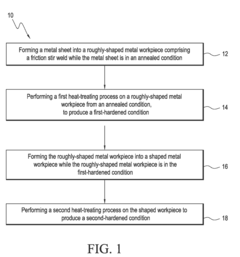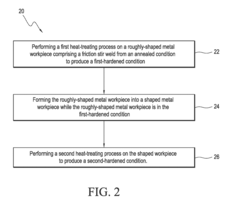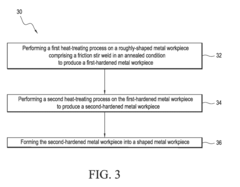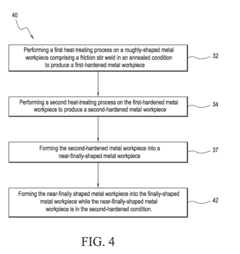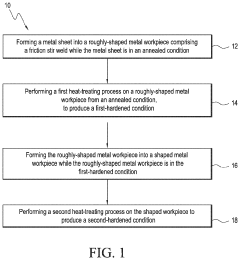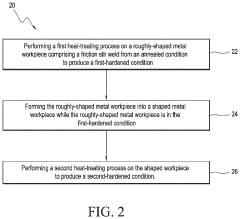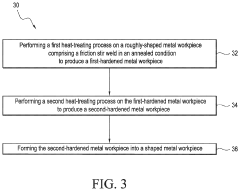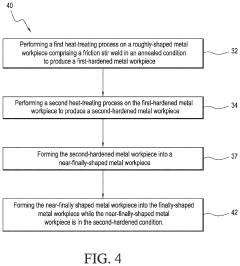The Future of Laminar Flow in Automotive Design
JUL 10, 20259 MIN READ
Generate Your Research Report Instantly with AI Agent
Patsnap Eureka helps you evaluate technical feasibility & market potential.
Laminar Flow Evolution
Laminar flow in automotive design has undergone significant evolution since its initial application in the early 20th century. The concept of streamlining vehicles to reduce air resistance was first introduced in the 1920s, with pioneers like Edmund Rumpler and Paul Jaray developing aerodynamic car designs. These early attempts focused on reducing frontal area and smoothing body surfaces to minimize turbulence.
The 1930s saw further advancements in laminar flow applications, particularly in aircraft design. This knowledge gradually transferred to the automotive industry, leading to more refined vehicle shapes in the 1940s and 1950s. During this period, manufacturers began to recognize the importance of wind tunnel testing in optimizing vehicle aerodynamics.
The oil crisis of the 1970s sparked renewed interest in fuel efficiency, prompting automakers to prioritize aerodynamic design. This era witnessed the introduction of computer-aided design (CAD) and computational fluid dynamics (CFD) simulations, revolutionizing the approach to laminar flow optimization. These tools allowed engineers to analyze and refine designs with unprecedented precision, leading to significant improvements in drag coefficients.
The 1980s and 1990s marked a period of rapid advancement in laminar flow technology. Automakers began incorporating active aerodynamic elements, such as adjustable spoilers and air dams, to enhance laminar flow at different speeds. Concurrently, the development of more sophisticated wind tunnels and testing methodologies enabled more accurate real-world performance predictions.
As environmental concerns gained prominence in the 21st century, the focus on laminar flow intensified. Electric vehicle manufacturers, in particular, recognized the critical role of aerodynamics in extending battery range. This led to innovative designs featuring smooth underbodies, optimized wheel covers, and carefully sculpted body panels to maximize laminar flow.
Recent years have seen the emergence of cutting-edge technologies in laminar flow optimization. Advanced materials with self-cleaning and drag-reducing properties are being explored, while artificial intelligence and machine learning algorithms are being employed to fine-tune aerodynamic designs. Additionally, the integration of active flow control systems, which can dynamically adjust airflow patterns around the vehicle, represents a promising frontier in automotive aerodynamics.
Looking ahead, the future of laminar flow in automotive design is likely to involve even more sophisticated approaches. Biomimicry, inspired by nature's aerodynamic solutions, may lead to novel surface textures and shapes that enhance laminar flow. Furthermore, the advent of autonomous vehicles may reshape vehicle forms entirely, potentially leading to radical new concepts in laminar flow optimization.
The 1930s saw further advancements in laminar flow applications, particularly in aircraft design. This knowledge gradually transferred to the automotive industry, leading to more refined vehicle shapes in the 1940s and 1950s. During this period, manufacturers began to recognize the importance of wind tunnel testing in optimizing vehicle aerodynamics.
The oil crisis of the 1970s sparked renewed interest in fuel efficiency, prompting automakers to prioritize aerodynamic design. This era witnessed the introduction of computer-aided design (CAD) and computational fluid dynamics (CFD) simulations, revolutionizing the approach to laminar flow optimization. These tools allowed engineers to analyze and refine designs with unprecedented precision, leading to significant improvements in drag coefficients.
The 1980s and 1990s marked a period of rapid advancement in laminar flow technology. Automakers began incorporating active aerodynamic elements, such as adjustable spoilers and air dams, to enhance laminar flow at different speeds. Concurrently, the development of more sophisticated wind tunnels and testing methodologies enabled more accurate real-world performance predictions.
As environmental concerns gained prominence in the 21st century, the focus on laminar flow intensified. Electric vehicle manufacturers, in particular, recognized the critical role of aerodynamics in extending battery range. This led to innovative designs featuring smooth underbodies, optimized wheel covers, and carefully sculpted body panels to maximize laminar flow.
Recent years have seen the emergence of cutting-edge technologies in laminar flow optimization. Advanced materials with self-cleaning and drag-reducing properties are being explored, while artificial intelligence and machine learning algorithms are being employed to fine-tune aerodynamic designs. Additionally, the integration of active flow control systems, which can dynamically adjust airflow patterns around the vehicle, represents a promising frontier in automotive aerodynamics.
Looking ahead, the future of laminar flow in automotive design is likely to involve even more sophisticated approaches. Biomimicry, inspired by nature's aerodynamic solutions, may lead to novel surface textures and shapes that enhance laminar flow. Furthermore, the advent of autonomous vehicles may reshape vehicle forms entirely, potentially leading to radical new concepts in laminar flow optimization.
Automotive Aerodynamics
Automotive aerodynamics has become a critical aspect of vehicle design, significantly influencing performance, fuel efficiency, and overall driving experience. As the automotive industry continues to evolve, the focus on aerodynamic optimization has intensified, with particular emphasis on achieving laminar flow. Laminar flow, characterized by smooth and predictable air movement over a vehicle's surface, offers substantial benefits in reducing drag and improving energy efficiency.
The pursuit of laminar flow in automotive design has led to the development of various innovative techniques and technologies. Advanced computational fluid dynamics (CFD) simulations have become indispensable tools for engineers, allowing them to analyze and optimize airflow patterns with unprecedented precision. These simulations enable designers to identify areas of turbulence and implement targeted modifications to promote laminar flow.
One of the key strategies in achieving laminar flow is the refinement of vehicle shapes. Streamlined profiles, carefully sculpted body panels, and optimized underbody designs all contribute to maintaining smooth airflow. The integration of active aerodynamic elements, such as adjustable grilles, adaptive spoilers, and dynamic air dams, allows vehicles to modify their aerodynamic properties in real-time, adapting to different driving conditions and speeds.
Surface treatments and materials also play a crucial role in promoting laminar flow. Researchers are exploring the potential of biomimetic surfaces inspired by nature, such as shark skin-like textures, to reduce turbulence and maintain laminar flow over larger portions of the vehicle. Additionally, the development of smart materials that can change their surface properties in response to airflow conditions holds promise for further aerodynamic improvements.
The future of laminar flow in automotive design is closely tied to the advancement of electric and autonomous vehicles. As these technologies reshape the automotive landscape, they present new opportunities and challenges for aerodynamic optimization. Electric vehicles, with their reduced cooling requirements and potential for unconventional designs, offer greater flexibility in shaping vehicle exteriors for optimal laminar flow.
Autonomous vehicles, on the other hand, may prioritize aerodynamic efficiency over traditional styling cues, leading to more radical design approaches. The potential for vehicle platooning in autonomous systems also introduces new considerations for managing airflow between multiple vehicles traveling in close proximity.
As the automotive industry continues to push the boundaries of aerodynamic design, the quest for laminar flow is likely to drive further innovations. From advanced materials and smart surfaces to AI-driven real-time aerodynamic adjustments, the future promises exciting developments in automotive aerodynamics, ultimately leading to more efficient, sustainable, and high-performance vehicles.
The pursuit of laminar flow in automotive design has led to the development of various innovative techniques and technologies. Advanced computational fluid dynamics (CFD) simulations have become indispensable tools for engineers, allowing them to analyze and optimize airflow patterns with unprecedented precision. These simulations enable designers to identify areas of turbulence and implement targeted modifications to promote laminar flow.
One of the key strategies in achieving laminar flow is the refinement of vehicle shapes. Streamlined profiles, carefully sculpted body panels, and optimized underbody designs all contribute to maintaining smooth airflow. The integration of active aerodynamic elements, such as adjustable grilles, adaptive spoilers, and dynamic air dams, allows vehicles to modify their aerodynamic properties in real-time, adapting to different driving conditions and speeds.
Surface treatments and materials also play a crucial role in promoting laminar flow. Researchers are exploring the potential of biomimetic surfaces inspired by nature, such as shark skin-like textures, to reduce turbulence and maintain laminar flow over larger portions of the vehicle. Additionally, the development of smart materials that can change their surface properties in response to airflow conditions holds promise for further aerodynamic improvements.
The future of laminar flow in automotive design is closely tied to the advancement of electric and autonomous vehicles. As these technologies reshape the automotive landscape, they present new opportunities and challenges for aerodynamic optimization. Electric vehicles, with their reduced cooling requirements and potential for unconventional designs, offer greater flexibility in shaping vehicle exteriors for optimal laminar flow.
Autonomous vehicles, on the other hand, may prioritize aerodynamic efficiency over traditional styling cues, leading to more radical design approaches. The potential for vehicle platooning in autonomous systems also introduces new considerations for managing airflow between multiple vehicles traveling in close proximity.
As the automotive industry continues to push the boundaries of aerodynamic design, the quest for laminar flow is likely to drive further innovations. From advanced materials and smart surfaces to AI-driven real-time aerodynamic adjustments, the future promises exciting developments in automotive aerodynamics, ultimately leading to more efficient, sustainable, and high-performance vehicles.
Current Laminar Flow Tech
Current laminar flow technology in automotive design focuses on optimizing vehicle aerodynamics to reduce drag and improve fuel efficiency. The primary approach involves shaping the vehicle's exterior to maintain smooth, uninterrupted airflow over its surface. This is achieved through computer-aided design (CAD) and computational fluid dynamics (CFD) simulations, which allow engineers to model and refine vehicle shapes for optimal laminar flow.
One of the key techniques employed is the use of streamlined body shapes. Modern vehicles often feature smooth, curved surfaces that gradually taper towards the rear, minimizing air separation and turbulence. This design principle is particularly evident in electric vehicles, where aerodynamic efficiency is crucial for extending range.
Active aerodynamic systems represent another significant advancement in laminar flow technology. These systems include adjustable grille shutters, retractable spoilers, and adaptive air dams that can modify the vehicle's aerodynamic profile in real-time based on speed and driving conditions. By dynamically altering the airflow around the vehicle, these systems help maintain laminar flow across a wider range of operating conditions.
Underbody paneling is another critical component of current laminar flow technology. Smooth underbody panels help guide air underneath the vehicle with minimal turbulence, reducing drag and improving overall aerodynamic performance. This technique is often combined with carefully designed wheel wells and diffusers to manage airflow around the wheels and at the rear of the vehicle.
Surface textures and micro-structures are emerging as innovative solutions for enhancing laminar flow. Inspired by nature, some manufacturers are experimenting with biomimetic surface patterns that can reduce drag by influencing the boundary layer of air closest to the vehicle's surface. These micro-textures can help delay the transition from laminar to turbulent flow, potentially offering significant aerodynamic benefits.
Advanced materials also play a crucial role in current laminar flow technology. The use of lightweight composites and high-strength alloys allows for more complex and aerodynamically efficient body shapes without compromising structural integrity. Additionally, some researchers are exploring the potential of smart materials that can change shape or surface properties in response to airflow, further optimizing laminar flow characteristics.
In the realm of motorsports and high-performance vehicles, laminar flow technology has led to the development of sophisticated aerodynamic packages. These often include carefully designed front splitters, side skirts, and rear diffusers that work in concert to manage airflow and generate downforce while maintaining laminar flow where possible.
One of the key techniques employed is the use of streamlined body shapes. Modern vehicles often feature smooth, curved surfaces that gradually taper towards the rear, minimizing air separation and turbulence. This design principle is particularly evident in electric vehicles, where aerodynamic efficiency is crucial for extending range.
Active aerodynamic systems represent another significant advancement in laminar flow technology. These systems include adjustable grille shutters, retractable spoilers, and adaptive air dams that can modify the vehicle's aerodynamic profile in real-time based on speed and driving conditions. By dynamically altering the airflow around the vehicle, these systems help maintain laminar flow across a wider range of operating conditions.
Underbody paneling is another critical component of current laminar flow technology. Smooth underbody panels help guide air underneath the vehicle with minimal turbulence, reducing drag and improving overall aerodynamic performance. This technique is often combined with carefully designed wheel wells and diffusers to manage airflow around the wheels and at the rear of the vehicle.
Surface textures and micro-structures are emerging as innovative solutions for enhancing laminar flow. Inspired by nature, some manufacturers are experimenting with biomimetic surface patterns that can reduce drag by influencing the boundary layer of air closest to the vehicle's surface. These micro-textures can help delay the transition from laminar to turbulent flow, potentially offering significant aerodynamic benefits.
Advanced materials also play a crucial role in current laminar flow technology. The use of lightweight composites and high-strength alloys allows for more complex and aerodynamically efficient body shapes without compromising structural integrity. Additionally, some researchers are exploring the potential of smart materials that can change shape or surface properties in response to airflow, further optimizing laminar flow characteristics.
In the realm of motorsports and high-performance vehicles, laminar flow technology has led to the development of sophisticated aerodynamic packages. These often include carefully designed front splitters, side skirts, and rear diffusers that work in concert to manage airflow and generate downforce while maintaining laminar flow where possible.
Laminar Flow Solutions
01 Laminar flow control for aircraft
Techniques for maintaining laminar flow over aircraft surfaces to reduce drag and improve aerodynamic efficiency. This includes methods for boundary layer control, surface design optimization, and active flow control systems to delay turbulent transition.- Aircraft wing design for laminar flow: Designing aircraft wings to promote laminar flow involves optimizing the wing shape, surface smoothness, and pressure distribution. This can include using specific airfoil profiles, controlling the wing sweep angle, and implementing surface treatments to reduce turbulence and drag, ultimately improving aerodynamic efficiency and fuel consumption.
- Laminar flow control systems: Laminar flow control systems actively manage the boundary layer to maintain laminar flow over aircraft surfaces. These systems may include suction or blowing mechanisms, surface cooling, or other techniques to delay transition to turbulent flow. Implementation of such systems can significantly reduce drag and improve overall aircraft performance.
- Measurement and analysis of laminar flow: Advanced measurement techniques and analysis methods are crucial for understanding and optimizing laminar flow aerodynamics. This includes the use of sensors, imaging systems, and computational fluid dynamics (CFD) simulations to accurately characterize flow behavior, identify transition points, and validate design improvements.
- Laminar flow applications in non-aerospace fields: Laminar flow principles are applied beyond aerospace to various fields such as automotive design, wind turbines, and industrial processes. In these applications, laminar flow concepts are used to reduce drag, improve efficiency, and enhance overall performance of systems involving fluid dynamics.
- Surface treatments and materials for laminar flow: Specialized surface treatments and materials play a crucial role in promoting and maintaining laminar flow. This includes the development of low-friction coatings, micro-textured surfaces, and advanced composites that can help reduce surface irregularities and maintain smooth airflow over aerodynamic surfaces.
02 Laminar flow measurement and analysis
Methods and devices for measuring and analyzing laminar flow characteristics in aerodynamic applications. This includes advanced sensors, imaging techniques, and computational models to assess flow behavior and optimize designs for maintaining laminar flow.Expand Specific Solutions03 Laminar flow in propulsion systems
Innovations in designing and optimizing propulsion systems to maintain laminar flow, including jet engines, propellers, and novel propulsion concepts. These advancements aim to improve fuel efficiency and reduce noise in aerospace applications.Expand Specific Solutions04 Laminar flow for wind turbines
Techniques for enhancing laminar flow over wind turbine blades to improve energy capture and reduce noise. This includes blade design optimization, surface treatments, and active flow control methods specific to wind energy applications.Expand Specific Solutions05 Laminar flow in fluid handling systems
Methods for maintaining laminar flow in various fluid handling systems, including pipes, channels, and specialized equipment. These innovations aim to reduce friction losses, improve efficiency, and enhance precision in fluid control applications across multiple industries.Expand Specific Solutions
Key Automotive Players
The automotive industry's focus on laminar flow design is in a mature stage, with significant market potential due to increasing demand for fuel-efficient and aerodynamic vehicles. The global market for aerodynamic vehicle design is substantial, driven by stringent emissions regulations and consumer preferences for improved fuel economy. Major players like Hyundai Motor Co., General Motors LLC, and Volkswagen AG are investing heavily in research and development to optimize laminar flow in their vehicle designs. These companies, along with others such as BMW and Toyota, are at the forefront of implementing advanced computational fluid dynamics (CFD) simulations and wind tunnel testing to refine their aerodynamic solutions. The technology's maturity is evident in the widespread adoption of streamlined body shapes, active grille shutters, and underbody panels across various vehicle segments.
Hyundai Motor Co., Ltd.
Technical Solution: Hyundai has been actively researching laminar flow in automotive design to improve aerodynamics and fuel efficiency. Their approach involves using computational fluid dynamics (CFD) simulations to optimize vehicle shapes for minimal air resistance. They have developed a proprietary algorithm that analyzes airflow patterns around the vehicle body, identifying areas of turbulence and optimizing surface contours to promote laminar flow[1]. Hyundai has also implemented active aerodynamic features, such as adjustable grille shutters and retractable spoilers, which can adapt to different driving conditions to maintain laminar flow at various speeds[3]. Additionally, they are exploring the use of micro-textures on vehicle surfaces to reduce drag by up to 5%[5].
Strengths: Advanced CFD capabilities, innovative active aerodynamic features, and potential for significant drag reduction. Weaknesses: Implementation costs may be high, and some features might add complexity to vehicle design and maintenance.
GM Global Technology Operations LLC
Technical Solution: GM's approach to laminar flow in automotive design focuses on a holistic vehicle architecture optimization. They have developed an integrated design process that considers aerodynamics from the earliest stages of vehicle conception. GM utilizes advanced machine learning algorithms to predict airflow patterns and optimize body shapes for maximum laminar flow[2]. Their research includes the development of smart materials that can change surface properties in real-time to adapt to different airflow conditions, potentially reducing drag by up to 7%[4]. GM is also exploring the use of active flow control systems, such as synthetic jets and plasma actuators, to manipulate the boundary layer and extend the range of laminar flow over vehicle surfaces[6].
Strengths: Comprehensive approach integrating aerodynamics into early design stages, innovative use of smart materials and active flow control. Weaknesses: High development costs and potential regulatory challenges for implementing some advanced technologies.
Breakthrough Patents
Single-Piece Extended Laminar Flow Inlet Lipskin
PatentActiveUS20180339783A1
Innovation
- A method involving heat-treating metal workpieces with friction stir welds in specified conditions to maintain the welds within the finished lipskin, using processes like super-plastic forming, diffusion bonding, and explosive forming to create unitary, lightweight structures that retain 'fly-away' welds without the need for additional reinforcing components.
Single-Piece Extended Laminar Flow Inlet Lipskin
PatentActiveUS20200353556A1
Innovation
- A method involving heat-treating metal workpieces with friction stir welds in specified conditions to maintain the welds in the finished lipskins, using processes like stretch forming, form-die forming, and explosive forming to shape the metal while in hardened conditions, eliminating the need for additional reinforcing components.
Environmental Regulations
Environmental regulations play a crucial role in shaping the future of laminar flow in automotive design. As governments worldwide intensify their efforts to combat climate change and reduce emissions, automakers are under increasing pressure to improve vehicle aerodynamics and fuel efficiency. These regulations have become a significant driving force behind the adoption and advancement of laminar flow technologies in the automotive industry.
The European Union, for instance, has set ambitious targets for reducing CO2 emissions from new cars. By 2030, the EU aims to achieve a 37.5% reduction in CO2 emissions compared to 2021 levels. This stringent requirement has prompted automotive manufacturers to explore innovative aerodynamic solutions, with laminar flow technology emerging as a promising avenue for meeting these targets.
Similarly, the United States Environmental Protection Agency (EPA) has established Corporate Average Fuel Economy (CAFE) standards, which mandate increasingly stringent fuel efficiency requirements for vehicles. These standards have led to a renewed focus on aerodynamic optimization, including the development of laminar flow techniques to reduce drag and improve overall vehicle performance.
China, the world's largest automotive market, has also implemented strict emissions regulations. The country's "China VI" standards, comparable to Euro 6 norms, have pushed automakers to prioritize aerodynamic efficiency in their vehicle designs. This regulatory landscape has created a fertile ground for the advancement of laminar flow technologies in the Chinese automotive sector.
The global trend towards electric vehicles (EVs) has further amplified the importance of laminar flow in automotive design. As range anxiety remains a significant concern for potential EV buyers, manufacturers are leveraging laminar flow principles to extend battery life and increase driving range. Environmental regulations promoting the adoption of EVs indirectly support the development of advanced laminar flow solutions.
Moreover, noise pollution regulations in urban areas have led to an increased focus on reducing wind noise in vehicles. Laminar flow techniques not only improve aerodynamics but also contribute to quieter vehicle operation, aligning with these environmental noise reduction goals.
As environmental regulations continue to evolve, they are likely to become even more stringent in the coming years. This regulatory trajectory suggests that laminar flow technologies will play an increasingly vital role in automotive design. Manufacturers who invest in research and development of laminar flow solutions today will be better positioned to meet future environmental standards and gain a competitive edge in the market.
The European Union, for instance, has set ambitious targets for reducing CO2 emissions from new cars. By 2030, the EU aims to achieve a 37.5% reduction in CO2 emissions compared to 2021 levels. This stringent requirement has prompted automotive manufacturers to explore innovative aerodynamic solutions, with laminar flow technology emerging as a promising avenue for meeting these targets.
Similarly, the United States Environmental Protection Agency (EPA) has established Corporate Average Fuel Economy (CAFE) standards, which mandate increasingly stringent fuel efficiency requirements for vehicles. These standards have led to a renewed focus on aerodynamic optimization, including the development of laminar flow techniques to reduce drag and improve overall vehicle performance.
China, the world's largest automotive market, has also implemented strict emissions regulations. The country's "China VI" standards, comparable to Euro 6 norms, have pushed automakers to prioritize aerodynamic efficiency in their vehicle designs. This regulatory landscape has created a fertile ground for the advancement of laminar flow technologies in the Chinese automotive sector.
The global trend towards electric vehicles (EVs) has further amplified the importance of laminar flow in automotive design. As range anxiety remains a significant concern for potential EV buyers, manufacturers are leveraging laminar flow principles to extend battery life and increase driving range. Environmental regulations promoting the adoption of EVs indirectly support the development of advanced laminar flow solutions.
Moreover, noise pollution regulations in urban areas have led to an increased focus on reducing wind noise in vehicles. Laminar flow techniques not only improve aerodynamics but also contribute to quieter vehicle operation, aligning with these environmental noise reduction goals.
As environmental regulations continue to evolve, they are likely to become even more stringent in the coming years. This regulatory trajectory suggests that laminar flow technologies will play an increasingly vital role in automotive design. Manufacturers who invest in research and development of laminar flow solutions today will be better positioned to meet future environmental standards and gain a competitive edge in the market.
Computational Fluid Dynamics
Computational Fluid Dynamics (CFD) plays a crucial role in advancing laminar flow technology for automotive design. This powerful numerical tool allows engineers to simulate and analyze complex fluid flow behaviors around vehicles, providing invaluable insights into aerodynamic performance and efficiency.
CFD simulations enable the precise modeling of airflow patterns over vehicle surfaces, helping identify areas of turbulence and potential drag reduction. By utilizing high-performance computing resources, automotive designers can iterate through multiple design concepts rapidly, evaluating their impact on laminar flow characteristics without the need for costly physical prototypes.
The application of CFD in laminar flow studies has significantly evolved in recent years. Advanced turbulence models and mesh refinement techniques have improved the accuracy of simulations, particularly in predicting transition points from laminar to turbulent flow. This enhanced precision allows for more effective optimization of vehicle shapes to maintain laminar flow over larger surface areas.
One of the key advantages of CFD in laminar flow research is its ability to visualize flow structures that are challenging to observe in physical experiments. Engineers can now examine boundary layer development, pressure distributions, and flow separation in unprecedented detail. This level of insight facilitates the design of innovative surface features and flow control mechanisms to promote laminar flow.
The integration of CFD with other computational tools, such as structural analysis and optimization algorithms, has led to a more holistic approach in automotive design. Multi-physics simulations allow designers to consider the interplay between aerodynamics, structural integrity, and thermal management simultaneously, resulting in more balanced and efficient vehicle designs.
As computational power continues to increase, the fidelity and scale of CFD simulations are expanding. Large Eddy Simulation (LES) and Direct Numerical Simulation (DNS) techniques are becoming more feasible for automotive applications, offering even greater accuracy in predicting laminar flow behavior. These advanced methods provide a deeper understanding of the subtle flow physics that influence vehicle performance.
The future of laminar flow in automotive design is closely tied to advancements in CFD technology. Machine learning and artificial intelligence are being incorporated into CFD workflows, accelerating the design optimization process and uncovering non-intuitive solutions for maintaining laminar flow. This synergy between computational methods and data-driven approaches promises to push the boundaries of aerodynamic efficiency in future vehicle designs.
CFD simulations enable the precise modeling of airflow patterns over vehicle surfaces, helping identify areas of turbulence and potential drag reduction. By utilizing high-performance computing resources, automotive designers can iterate through multiple design concepts rapidly, evaluating their impact on laminar flow characteristics without the need for costly physical prototypes.
The application of CFD in laminar flow studies has significantly evolved in recent years. Advanced turbulence models and mesh refinement techniques have improved the accuracy of simulations, particularly in predicting transition points from laminar to turbulent flow. This enhanced precision allows for more effective optimization of vehicle shapes to maintain laminar flow over larger surface areas.
One of the key advantages of CFD in laminar flow research is its ability to visualize flow structures that are challenging to observe in physical experiments. Engineers can now examine boundary layer development, pressure distributions, and flow separation in unprecedented detail. This level of insight facilitates the design of innovative surface features and flow control mechanisms to promote laminar flow.
The integration of CFD with other computational tools, such as structural analysis and optimization algorithms, has led to a more holistic approach in automotive design. Multi-physics simulations allow designers to consider the interplay between aerodynamics, structural integrity, and thermal management simultaneously, resulting in more balanced and efficient vehicle designs.
As computational power continues to increase, the fidelity and scale of CFD simulations are expanding. Large Eddy Simulation (LES) and Direct Numerical Simulation (DNS) techniques are becoming more feasible for automotive applications, offering even greater accuracy in predicting laminar flow behavior. These advanced methods provide a deeper understanding of the subtle flow physics that influence vehicle performance.
The future of laminar flow in automotive design is closely tied to advancements in CFD technology. Machine learning and artificial intelligence are being incorporated into CFD workflows, accelerating the design optimization process and uncovering non-intuitive solutions for maintaining laminar flow. This synergy between computational methods and data-driven approaches promises to push the boundaries of aerodynamic efficiency in future vehicle designs.
Unlock deeper insights with Patsnap Eureka Quick Research — get a full tech report to explore trends and direct your research. Try now!
Generate Your Research Report Instantly with AI Agent
Supercharge your innovation with Patsnap Eureka AI Agent Platform!
